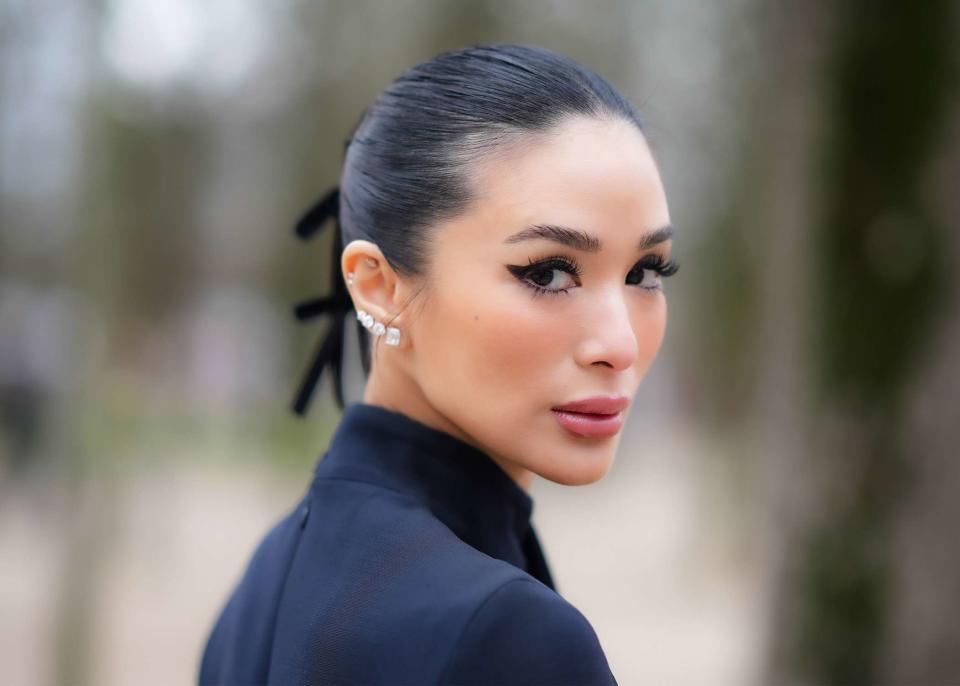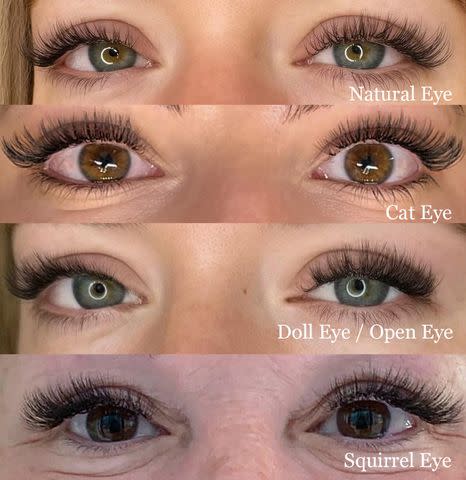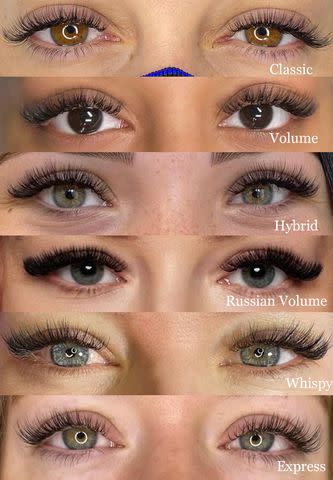Pros Explain All the Different Types of Lash Extensions
So you can find the perfect fit.

Getty Images
When you head to a lash specialist for fluttery extensions, they use their expertise to curate the most perfect-for-you set. “Lashes aren’t one size fits all,” says Trina Dial, the founder of Maven Artistry. “A good artist will assess your facial features and guide you in selecting the most suitable look.”
As a result, there are tons of options to consider before heading to your appointment. Everything from the curl type to the style of lashes can completely change your look. “Depending on the style, a lash artist can add anywhere from 60 to 600+ lashes to each eye on the first application,” says Dial.
To help you understand the ins and outs of different types of lash extensions, you'll find an exhaustive guide, below.
Materials to Consider
“Ninety-nine percent of the individual lash extensions on the market are made from synthetic materials, as most everyone in the eyelash community has moved away from using animal hair,” advises Dial. Here are the three most popular materials available:
Synthetic Lashes: The most common of all lash extensions, synthetic lashes are made of a nylon fiber called polybutylene terephthalate (PBT). “The lashes have a satin-like finish and a slightly stiff feel,” says Cynthia Tsang, the founder of Lash L’Amour in Boston.
Faux Silk: Shiny and glossy, faux silk lashes are created out of a plastic fiber designed to resemble silk. “Because they’re lightweight, they tend to stay on longer than other synthetic lashes and are a good option for those with fine or weak lashes,” says Tsang.
Faux Mink: Made of a synthetic fiber designed to mimic real mink fur, faux mink extensions have a rich, matte finish and a soft feel,” says Dial. “They’re great for creating an airy, wispy look.”
Lash Extensions by Eye Shape

Natural Eye: This shape enhances natural lashes without drastically changing their appearance and is a great option for someone who wants a minimal makeup look. “Shorter extensions are placed towards the inner corner of the eye, gradually increasing in length and thickness towards the outer corner,” says Tsang, who adds the look works on all eye shapes.
Cat Eye: Longer, thicker lashes are applied to the outer quarter of the eye and tapered towards the inner corner. “The result is a sexy, wing-like effect,” says Robyn Fisher, owner of Makeup by Robyn Fisher. The look can be customized from subtle to dramatic and works best on almond-shaped eyes, round eyes, close-set eyes, and downturned eyes.
Doll Eye/Open Eye: Otherwise known as an open eye style, this shape gives off a wide-eyed look with lashes that are longer and more dramatic at the center of the lash line and lashes that taper toward the outer and inner corners. They work best on round and almond shapes and downturned eyes.
Squirrel Eye: With this look, lashes are shorter on the inner corner, longer towards the arch of the brow, and slightly tapered on the outer corner. “The longest lashes are focused above the iris to create both the open doll and sexy cat effect. They’re great for close-set eyes, high-brow arches, or for lashes that grow downwards,” notes Fisher.
Styles of Lashes

The type of lash you choose will be determined by the shape of your eyes and face and the look you’re trying to achieve. The most common types include:
Classic Lashes: Applied one at a time, classic lashes are subtle and perfect for everyday wear. “Of all the lashes, they’re the most natural looking and a safe bet for someone just starting out although some clients find they don’t offer enough volume,” says Malin Singleton, the owner of Art of Lash.
Volume Lashes: Volume lash extensions involve the application of multiple lightweight lash extensions to each natural lash. “A lash artist creates handmade lash fans by grouping several fine extensions together with the result being a dark and feathery look,” says Singleton. “They’re easily customizable but there’s a lot of maintenance—refills can take up to two hours.”
Hybrid Lashes: The hybrid technique combines classic and volume applications, resulting in a textured, wispy, lash line that still appears natural. “Hybrid sets are customizable and maintain their natural appearance as they grow and shed,” explains Singleton. “But they can be more expensive than classic and not as full as volume lashes.”
Russian Volume Lashes: These extensions mimic the appearance of a bold, winged eyeliner, providing fullness and density across the entire lash line. “They’re created using short, lightweight lashes and tend to have an impressive six-to-eight-week retention period due to their ability to wrap around and hold onto the natural lash,” notes Singleton. “But when the extensions shed, the eyes can look uneven.”
Wispy Lashes: Otherwise known as a staggered, textured, or strip lash, the technique involves fanning multiple extensions at various points along the lash line, creating wispy lashes that can be either light and airy or dense and intense. “The final look is determined by how the fans are layered and in many cases spikes—long individual lashes or closed volume fans—are added to the extension to create texture,” says Tsang, who notes more frequent fills may be necessary due to the varying lengths and angles of the lashes.
Express Lashes: Typically made of synthetic mink and consisting of multiple, ultra-thin individual lashes attached together in a fan shape, express lashes utilize premade volume fans to speed up application time. “They can often be applied in less than an hour but can have a uniform look,” says Tsang.
Curl Options
There are different types of curl patterns and lengths to choose from and they’re often identified by letters. “Your lash artist will discuss which option is best for you based on your eyes and lifestyle,” says Singleton. Here are five of the most popular choices:
J Curl: The slight curl at the end of this extension resembles the letter J and is perfect for those seeking volume and lift without a lot of drama.
B Curl: With a straight base and a curled tip, this extension provides a little more lift than a J curl.
C Curl: Considered the most popular, a C curl mimics the shape of a naturally curled lash.
D Curl: The curliest of all lash extensions, the D curl provides dramatic volume and lift.
L Curl: Often called the “Barbie” curl for its dramatic look, the L curl has a flat base followed by an extreme lift resembling the letter “L”.
Other Factors to Keep in Mind
Getting the Right Thickness
To determine thickness, your lash artist will assess the strength, condition, and length of your natural lashes and discuss your desired look. “Healthy and strong lashes can accommodate more dense and full extensions, while short or sparse lashes do better with ones that are more thin and less voluminous,” advises Dial. “Generally speaking, extensions range in size from .02mm to 0.25mm. “Yet anything over .18mm is no longer recommended or stocked by reputable lash artists as they can result in breakage and poor retention,” says Dial.
Choosing the Right Length
Lash extensions come in various lengths, typically ranging from .06mm to .16mm (although they can be as short as .03mm and as long as .25mm), to accommodate different styles. “Shorter lengths (.06mm to .11mm) provide a more natural look, while longer lengths (.12mm to .16mm) offer a dramatic and bold appearance,” says Tsang. “The rule of thumb is to not add an extension longer than 30% of the entire length of the natural lash.”
Matching the Color to Your Natural Lashes
Black has always been the go-to lash extension color but many artists now match extensions with their client’s natural hair shade. “We’re seeing blonde, auburn, brown, and even white and gray lash extensions,” says Dial, who explains it’s common to use one or more of these colors to achieve a desired effect. There’s also a market for colored lashes, including pink, green, purple, blue, and burgundy. “You can add a pop of color to a small section of lashes, cover all the lashes in one color, or mix in different hues,” says Tsang. “The upkeep is no different than with traditional black extensions and the color won’t fade.”
For more InStyle news, make sure to sign up for our newsletter!
Read the original article on InStyle.

